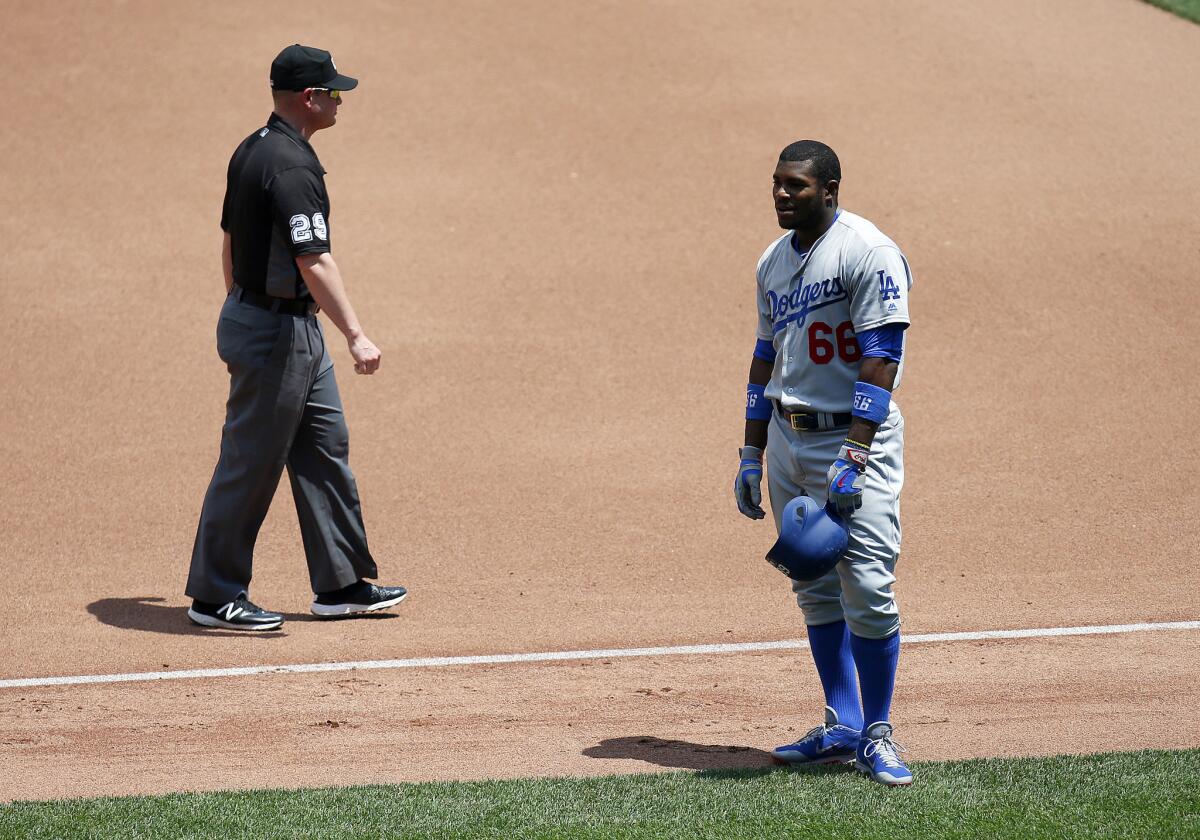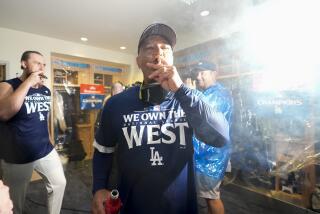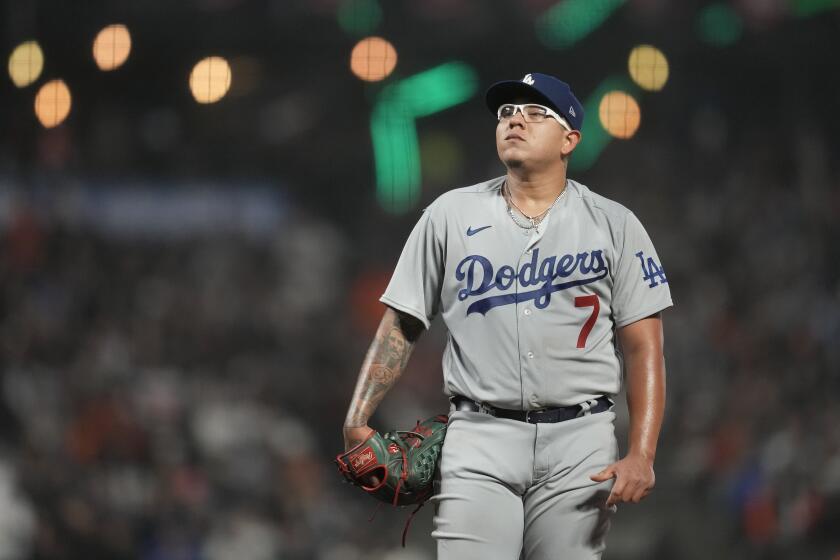Dodgers send Yasiel Puig to minor leagues, leaving his future with team unclear

Reporting from Denver â One day this spring, Dave Roberts asked Yasiel Puig to dinner. During his first camp as manager of the Dodgers, Roberts attempted to build relationships up and down his roster. But only one player received an invitation like this. Puig merited the extra attention, Roberts felt.
Inside a clubhouse riven with mistrust during Don Mattinglyâs tenure, Puig loomed as the most divisive figure. After he accepted the managerial position, Roberts promised Puig a clean slate. Seated alongside first-base coach George Lombard at dinner, Roberts reinforced that message.
We believe in you. We care about you. We only want the best for you.
By the last day of July, the tenor of the message was slightly different.
âWeâve been consistent with him as far as our desire for him to be a better person and baseball player,â Roberts said on Sunday. âThereâs been some injuries, and he hasnât performed the way heâs wanted to.
âBut I think as a coach, we have to concern ourselves with the whole team. As much as I care about him and I want him to be great, I mean, guys have to take ownership and be accountable for themselves, as a grown man.â
The Dodgers delivered that message with a roster maneuver Tuesday, demoting Puig to the minor leagues one day after failing to trade him at the non-waiver deadline. The decision follows the acquisition of outfielder Josh Reddick on Monday.
Puig is expected to report to triple-A Oklahoma City by this weekend. Before Tuesdayâs game at Coors Field, General Manager Farhan Zaidi framed Puigâs demotion as âa chance to work on some things and develop further as a player.â But he declined to place a percentage on the chance Puig ever plays again for the Dodgers.
âI donât want to handicap that situation,â Zaidi said. âItâs certainly a possibility. Beyond that is just speculation.â
As Zaidi explained it, the âprimaryâ reason for Puigâs departure was Reddickâs arrival. Reddick carried an .816 on-base-plus-slugging percentage into Tuesday. Puig had a career-worst .706 OPS.
But Zaidi acknowledged that Puigâs behavior was a factor. The organization did not portray Puig as an irreconcilable malcontent, crippling the club with his personality. The issues were smaller and subtler, a series of minor indiscretions that piled up.
Despite his ubiquitous Twitter hashtag, Puig sometimes showed up late to meetings. He displayed only intermittent interest in the work necessary to avoid injury. Roberts acknowledged Puig lacked consistency in his habits. âYasiel has to continue to grow,â he said.
âThere are certainly things we believe he could do better off the field,â Zaidi said. âAnd those have been communicated to him. I donât want to elaborate on it further.â
Team officials acknowledged a correlation between Puigâs preparation and his performance. If Puig dedicated himself to activities geared toward injury prevention, he might not have recurring hamstring issues. If he established a more concrete pregame routine, he might maintain his mechanics at the plate.
The lackluster hitting became apparent this season, as pitchers followed a simple blueprint: Heaters on the hands, breaking balls away. Always vulnerable to offspeed pitches, Puig now could not handle fastballs, the pitch he once punished in savage fashion.
Some talent evaluators felt his muscularity reduced his dexterity. This forced him to guess what pitchers were throwing, rather than observing and reacting.
âTo get his body going, he has to decide to swing so much earlier than most other hitters,â one rival scout said. âThatâs why you see him swinging at sliders in the other batterâs box.â
Puig spent three weeks on the disabled list in June with a hamstring strain. After his return, he hit .308 with an .830 OPS. Yet the organization still preferred to send him down, rather than install him as the right-handed half of a platoon with the left-handed-hitting Reddick.
By sending Puig to the minors, the Dodgers can showcase him to any interested clubs while avoiding the hassle of his reaction to reduced playing time. The team is expected to continue to look to trade him.
For rival talent evaluators, the most troubling aspect of his performance was his declining athleticism. Upon his arrival in 2013, Puig displayed explosiveness in the field and on the bases. Four years later, with his frame bulkier and his legs increasingly vulnerable to muscle strains, the electric moments were rare.
âHeâs a little bit more static, a little more stiff,â Roberts said, as compared to his rookie season.
The organization asked Puig to shed weight this winter. He built his diet around fruit and fish, and dropped 15 pounds. Roberts first met with Puig in January to establish rapport. On multiple occasions, Roberts reassured Puig that the coaches were invested in his success.
Puig showed signs of understanding. During camp, he did not plug headphones into his ears to shut out the world. He greeted teammates in the hallways and dueled with them in video games. âIâve been really impressed with him this spring,â Clayton Kershaw said in February.
During the first weekend of the season, Puig crackled with the electricity of 2013. He tripled in each of the first two games. He homered in the third. He affected a comical embellishment of patience, sprinting to first base on walks.
Away from the park, Puig found a comedic touch on Twitter. He was photographed standing alone on the teamâs plane, pondering the whereabouts of the rest of the traveling party. His hashtag idiom, #PuigNotLate, spawned a variety of iterations: #PuigHungry, #PuigNotScared and #PuigYourFriend.
The flair excited fans. The discipline heartened the team. Neither would last.
The messages on social media petered out as his production cratered. During a 46-game stretch after the first week of the season, Puig hit .213. He walked four times in 166 plate appearances.
As Puigâs average plummeted, Roberts clung to his acumen in right field and his brio on the bases as reasons for optimism. Then, on May 24, Roberts benched Puig for admiring a long, towering drive rather than sprinting out of the box. The ball went off the fence but Puig got only a single out of it.
A few days after his behavior regressed, so did Puigâs body. On the final day of May, he could not get his left hamstring loose. He landed on the disabled list four days later.
Back in the lineup in late June, Puig appeared to find a rhythm. Then he injured his other hamstring, which led to a week on the bench. Tired of waiting for Puigâs body to cooperate and his attitude to improve, the Dodgers targeted Reddick.
On Tuesday afternoon, as he prepared to manage his first game with Puig in the rearview mirror, Roberts admitted he spent more time focusing on his former right fielder than any other Dodger.
âThe goal, especially at this level, is time should be distributed evenly,â Roberts said. âAnd I think Yasiel understands that. And this is something that we expect him to understand, that this is not punitive. Itâs for his growth. To become, ultimately, a better baseball player.â
Twitter: @McCulloughTimes
MORE ON DODGERS
Bill Shaikin: Dodgers try to play catch-up to Giants on trade front
Dodgers get reliever Jesse Chavez from Toronto for Mike Bolsinger
Bud Norrisâ injury Sunday adds urgency to Dodgersâ search for starting pitching
More to Read
Are you a true-blue fan?
Get our Dodgers Dugout newsletter for insights, news and much more.
You may occasionally receive promotional content from the Los Angeles Times.








